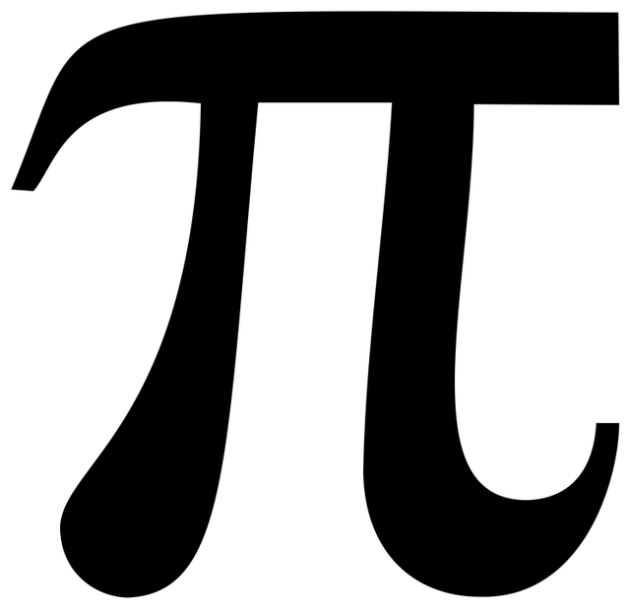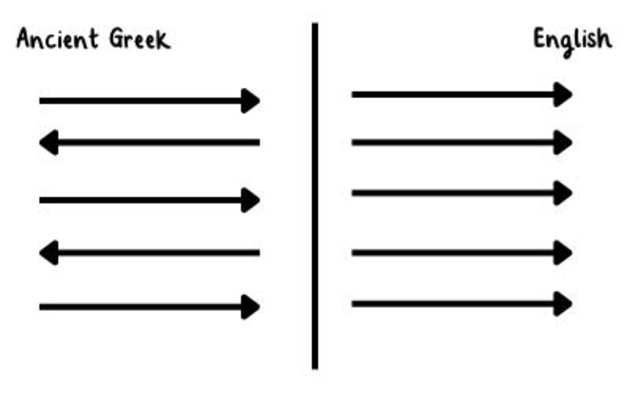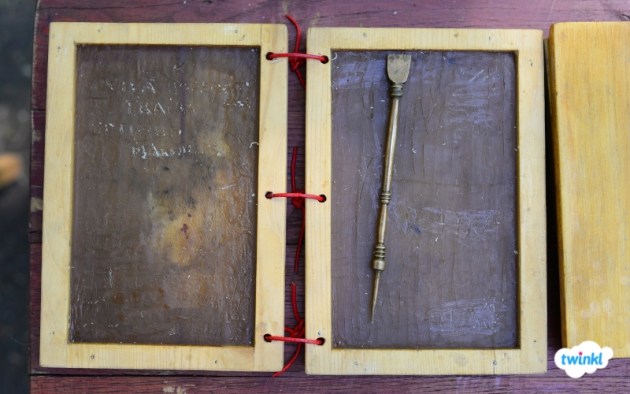
What is the Ancient Greek Alphabet?
Ancient Greek Alphabet


When was the Ancient Greek alphabet invented?
The Ancient Greek alphabet is a writing system developed in Greece, it first appeared in records during the 8th century BC.
The Greeks developed their alphabet from the Phoenicians, taking many letters from their alphabet and adding a few of their own. The Phoenicians were based in Lebanon and were known for being maritime merchants. They would carry goods that they would sell however, their writing system was probably their most valuable commodity. In time, they would spread their influence west.

Before the 5th century BC, the Greek alphabet was divided into Ionic (eastern) and Chalcidian (Western) branches. There were very small differences between the two. In 403 BC, the Ionic alphabet was adopted in Athens and over the next 50 years, all local Greek alphabets were replaced by the Ionic alphabet. This later became the Classical Greek alphabet.
The Greek alphabet is still used to this day! Its letters are used in science and maths representing different constants, variables, and functions. In the United States, these letters are popular amongst college fraternities and sororities.
How many letters are in the Ancient Greek alphabet?
So, how many letters are in the Ancient Greek alphabet? Well, the classical Greek alphabet contains twenty-four letters, seven of which are vowels.
Here are the twenty-four letters of the Greek alphabet, in both uppercase and lowercase:
- Alpha - Α, α
- Beta - Β, β
- Gamma - Γ, γ
- Delta - Δ, δ
- Epsilon - Ε, ε
- Zeta - Ζ, ζ
- Eta - Η, η
- Theta - Θ, θ
- Iota - Ι, ι
- Kappa - Κ, κ
- Lambda - Λ, λ
- Mu - Μ, μ
- Nu - Ν, ν
- Xi - Ξ, ξ
- Omicron - Ο, ο
- Pi - Π, π
- Rho - Ρ, ρ
- Sigma - Σ, σ, ς
- Tau - Τ, τ
- Upsilon - Υ, υ
- Phi - Φ, φ
- Chi - Χ, χ
- Psi - Ψ, ψ
- Omega - Ω, ω
In this list, you’ll recognise that some letters look the same as the English alphabet. There are ten letters that resemble their uppercase English equivalents. These areA, B, E, I, K, M, N, O, T and Z.

Numbers in Ancient Greek
What about writing numbers in Ancient Greek? Well, the Greeks created a handy system of using the letters from their alphabet to represent numeric values too. They added three values to the alphabet to make twenty-seven numerals. Here are the three additions:
- Digamma (ϛ) - this equates to 6.
- Koppa (ϟ) - this equates to 90.
- Sampi (ϡ) - this equates to 900.
So what did these numbers in Ancient Greek look like in practice?
- The first nine letters of the alphabet (from alpha to theta and including digamma) were used for values 1-9.
- The next nine letters (from iota to koppa) were used as multiples of 10, going from 10 up to 90.
- The final nine letters (from rho to sampi) were used for multiples of 100, going from 100 up to 900.
- Greek letters used in other subjects
Greek letters have been used in subjects such as science and maths to represent constants, variables, and functions. Here are a few examples of them in action:
- π Pi - used in mathematics as the value of a constant equal to 3.141 (to 3 decimal places).
- Δ Delta - used to represent a difference or change in quantity.
- λ Lambda - used in physics to represent the wavelength of light.
- Σ Sigma - represents a sum of a number of different items.
- θ Theta - often used to represent an angle.

Other scripts that have derived from the Ancient Greek alphabet
Once the Greek alphabet had been unified in 403 BC in Athens, they essentially had their own official alphabet. Greece then started to grow its influence in the Mediterranean world, with lots of different communities being exposed to their idea of writing.
These communities used the Greek system of writing as a model and developed their own writing methods from this. The Italian peninsula was a Western version of the Greek alphabet used by Greek colonists in Sicily.
Old Italic scripts were the source of the Latin alphabet and these were created by Etruscans and Messapians who used the Greek alphabet as inspiration. The Coptic alphabet was also derived from the Greek alphabet, and this was introduced when the Greeks gained control of Egypt during Hellenistic times.
In the near east, there were also many groups who created their own versions of the alphabet based on the Greek one. They include:
- The Carians
- The Lycians
- The Lydians
- The Pamphylians
- The Phrygians
Although in recent times the Greek alphabet is mainly used for the Greek language, it is the root script of many Western world scripts that exist today!
Ancient Greek writing
Ancient Greek writing was formatted differently from how we read English. So in English, sentences are written from left to right. Whereas, in Ancient Greek sentences start from left to right then the following line is right to left, then back to left to right again and so on. To help you visualise this, we’ve created this handy diagram comparing the direction of sentences in English and Ancient Greek.

Discovered in the 1960s is one of the oldest examples of Greek handwriting. This is a carbonised roll of papyrus from around the end of the 4th century BC. Papyrus was a common writing material and many more texts have been discovered dating from this time. Papyrus is a bit like thick paper and is made from the pith of papyrus plants. Other ancient cultures used this writing material. The Egyptians, in particular, used papyrus a lot as this was an abundant plant near the Nile. To write on the papyrus the Ancient Greeks would have used a hard piece of reed cut with a nib and ink.

The Ancient Greeks also did a good amount of writing on wax tablets. Constructed of boards of wood, or sometimes ivory, and coated with a layer of wax (often beeswax). Often two tablets would be connected, so they could fold shut - a bit like a notebook. The Ancient Greek writing would be incised with a stylus made of metal, ivory or even sometimes bone. Because writing was carved into wax, it could be scraped or smoothed flat again when you wanted to write something new. This made wax tablets really useful for everyday writing, like making notes or keeping records. Wax tablets were commonly used in schools for pupils to do their work on.
In Ancient Greece, writing would also be carved into stone. Usually, this was important writing in a public place for people to read and often featured laws.
Nine interesting facts about the Ancient Greek alphabet
You can easily share these nine incredible facts about the Ancient Greek alphabet in your lessons today!
- The Ancient Greek alphabet first appeared in records during the 8th century BC.
- The word ‘alphabet’ is derived from the first two letters of the Greek alphabet - ‘alpha’ and ‘beta’.
- Other alphabets such as Latin exist because of the Greek alphabet.
- The Greek alphabet was in fact the first alphabet to use vowels.
- Latin and Greek alphabets are closely related, with lots of the letters looking the same. These letters don’t always sound the same, though.
- The first Ancient Greek alphabet didn’t have lower and uppercase letters, this was developed later on.
- How many letters are in the Ancient Greek alphabet? The alphabet contains twenty-four different letters.
- The Ancient Greek alphabet was used to represent letters, but also numbers in ancient Greek (numerals).
- The Greek alphabet is the root script of many Western world scripts we use today!
Teaching resources about the Ancient Greek alphabet
We have a great collection of resources that will help you teach the Ancient Greek alphabet that you can use in your lessons today!
Our excellent Ancient Greek Writing Alphabet Poster is a fantastic display tool that you can use in your classroom. You could create an informative Ancient Greek alphabet display area on one of your classroom walls using this poster as the centrepiece.
We also have some eye-catching Ancient Greek Alphabet Display Lettering. This resource would also make a brilliant addition to any classroom display. If this isn’t enough, we have a Greek Alphabet Display Pack that includes a wide variety of display materials.
Challenge the children in your class with this engaging Ancient Greece Alphabet Matching Activity. This activity will help children develop their understanding of the Greek alphabet. They will enjoy the matching aspect of this fun exercise!
 Home
Home  Membership
Membership  TwinklCares
TwinklCares  Updated Help for 2022
Updated Help for 2022  Catch-up Resources
Catch-up Resources  Home Learning Hub
Home Learning Hub  Create
Create  Blog
Blog 




















